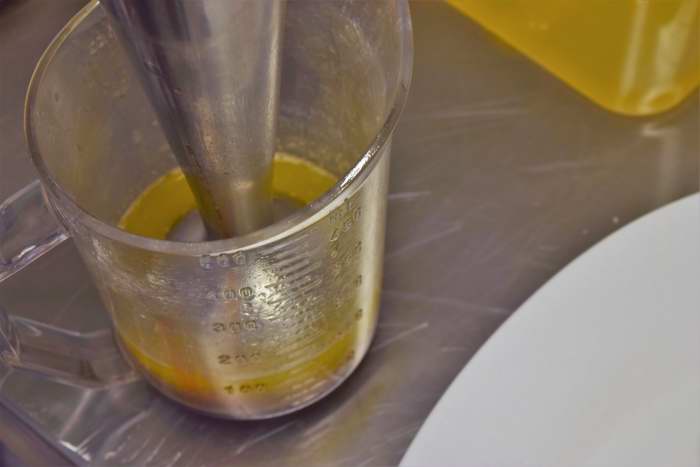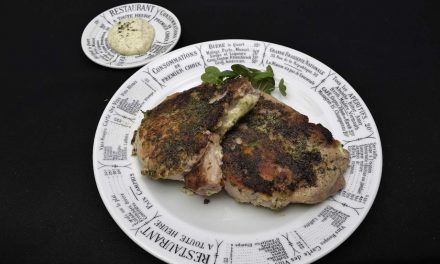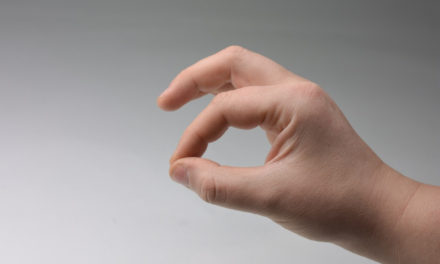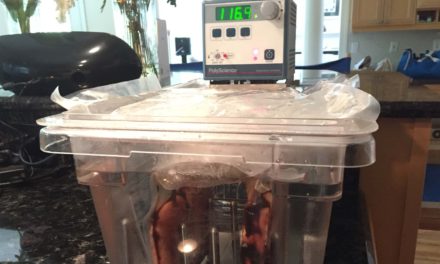Oil and water don’t mix. Or, do they?
This is not an immutable law of nature, but it is used commonly in non-culinary conversation enough that most people understand the basic idea. That being said, my admittedly empirical research clearly demonstrates that most people cannot tell you whether it is the water or the oil that sinks when the two come in contact. This is even true of cooks.
My research indicates about a 50/50 balance of wrong and right answers. Furtive glances and an indecisive series of mumbled comments usually precedes what appears to be a wild guess. As confirmation, if you ask people which of the two liquids is heavier, or denser, again, you get about 50/50 wrong vs right. If you ask which one is thicker, most people will point at the oil, almost stunned by the stupidity of the question.
And that’s the problem. In our minds, we would expect thicker liquids to be heavier than thin ones. Surely, molten metal and mercury (a metal molten at room temperature) are denser and heavier than water. And, they are. But not because they’re thick. Because they’re METAL!
Come Together
Emulsification combines oil and water into a homogenous mix, of varying temporal stability. Even homogenization is a form of emulsification, come to think of it. The resulting thickness can range from almost water like to free standing like mayonnaise. For that matter, hard cheese is an emulsion, albeit a quite solid one.
Egg yolks and egg whites are emulsions. Vinaigrettes are emulsions, at least until they break and settle. Dairy products are emulsions, including ice cream. Chocolate. Dairy products are such stable emulsions that they are actually USED to emulsify other products. So, emulsion was not invented. It was discovered. If it’s creamy, it’s probably an emulsion.
Oil and water have different electrical charges in their distinct molecules. Water molecules are polar. Not like bears, and not like bi-polar. Water doesn’t eat seals or get depressed or manic, so far as we know. How would we know? Okay, whatever.
A different kind of negativity.
Water molecules have a negative charge on one end and a positive charge on the other. I try to imagine nano-microscopic batteries with a little female thingy on one end and a little male thingy on the other, but I can’t do it. Anyway, water molecules tend to attract water molecules and line up, sort of like those batteries they put in Teslas.
Oil molecules are not polar. I don’t know if they can be bi-polar. Allegorically, water and oil aren’t interested in getting to know each other. When they encounter each other, the water heads for the basement, and the oil gets on the up elevator. Neither one wants to go to counseling, either. It’s really hard to get them together.
Emulsifiers, like cream, can lure both water and oil into believing that they could all hang out. An emulsifier has the ability to attach itself to water AND oil. Sort of like a good diplomat. “You don’t like him, and he doesn’t like you, but you can still do business–and I can help.”
Don’t get the emulsion in your eyes.
Soap is a surfactant, and that’s a thing too, but we’re not gonna talk about that today. Let’s just acknowledge that soap knows how to make the grease think it’s water, so it can go down the drain without clogging. That’s no mean feat. Yay, soap!
When the scientists start talking about emulsions, they start using those expressions “continuous phase” and “dispersed phase.” I get kind of lost right about then. All that it really amounts to, though, is that the continuous phase is the liquid that there’s the least of, and the dispersed phase is the stuff that there’s the most of. I think.
In other words, when the oil is slowly whisked into the vinegar with a little bit of mustard, the vinegar is the continuous phase stuff, and the oil gets dispersed in it. There’s another metaphor that I like better, even though using literary personification is considered kind of hack.
Anthropomorphism.
Friction or an actual emulsifying agent CONVINCES the oil that it’s actually water. Like a good movie, as long as the suspension of disbelief continues, the oil droplet will keep acting like water, mingling in the crowd of wateriness as if it belonged there. If, however, it runs into another droplets of oil, there is a risk that they will conjugate and gather a bunch of other oil droplets together, thereby crashing the whole party.
News Flash: OH, NO!
This part I don’t get. Emulsions can work either way, with the same end result. Apparently, not only can the oil be made to act like water, the water can be made to act like oil. Wait. Whutt? What was once continuous is now dispersed. It’s like the Rolling Stones breaking up or something.
As if that wasn’t confusing enough, the type of emulsion is independent of the actual amounts of oil and water we’re working with. The balance of volumes affects the apparent thickness. The emulsion may be short lived, but it’s still an emulsion, if but for that brief moment. Some emulsions, like mayonnaise, are like the Stones, seemingly eternal. Other emulsions are more like Vanilla Ice, or that Rico Suave guy. They cling for a while, and then they go back to their old behaviors. They WERE emulsions; at least, they have THAT.
Whip It.
Cream and butter. Butter and cream. Both are emulsions. Cream is oil (butter fat) dispersed in water (milk), so it has the properties of a liquid. Butter is water (milk) dispersed in oil (butter fat), so it has the properties of a solid, at room temperature. If you add enough friction by earnestly churning the cream, you reverse the existing emulsion. This results in some of the water (milk solids, buttermilk, whatever) being left behind. But those two things seem extremely different from each other. I remember churning butter, but that was long ago.
If you ask people today where butter comes from, not only might their answers surprise you. If you assert that butter originally came from a cow’s breast (udder), you may be in for an argument. In answer to the question “how do you make butter?” I have heard professional cooks go right down a list that includes garlic, olive oil, salt, white pepper, and who knows what all else.
Emulsify This.
The Hard Way
Localized friction will create an emulsion. A stick blender is the easiest and most observable way of doing this. Hold a stick blender in a clear, narrow container, like a measuring cup, IN the water based liquid. Start pulsing the motor, and oil in the top of the container will slowly get pulled down into the bottom. You can even see a little whirlpool/vortex thing while it’s happening. The blender is undoing and then re-homogenizing the two distinct substances. Very convincing.
Stuff
The egg yolks in hollandaise and mayonnaise, the garlic and mustard in aioli, the cream in Alfredo sauce, these all assist in the creation of emulsions. But thickeners like flour or cornstarch aren’t really doing the same thing. Those kinds of thickeners have some emulsifying properties, but, well, they’re kind of cheating. It’s like we finally got water and oil in the same room, but it’s a masquerade party. We didn’t REALLY bring them together, even though it looks like we did. We’ll go deeper into that some other time.
There’s more. A LOT more. Emulsions are a thing. We will continue. I think I need some time to digest this myself!
Norm





